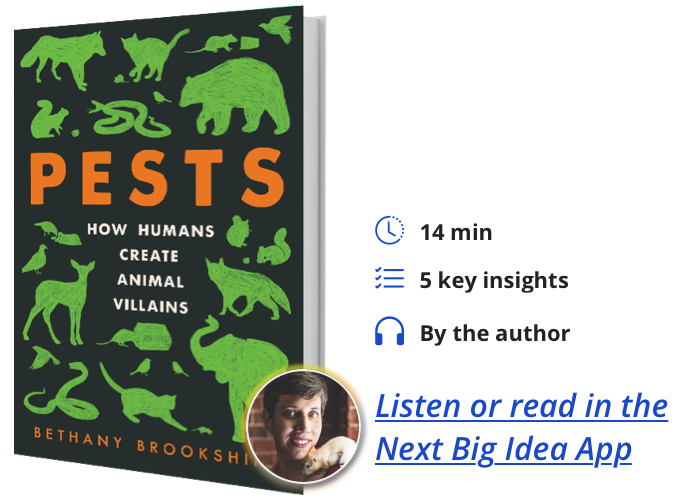Bethany Brookshire is a science journalist and host of the Science for The People podcast.
Below, Bethany shares 5 key insights from her new book, Pests: How Humans Create Animal Villains. Listen to the audio version—read by Bethany herself—in the Next Big Idea App.
1. What we call a pest is an animal success.
We in the West love animals, but we often only love the lions, tigers, and, bears that we rarely see in our day-to-day lives. Common rats and pigeons are pests, animals not where they belong. But in fact, these animals are wildlife too. They have succeeded because they tag along with us and we hate them for their very success. We want animals to thrive, of course. We just don’t want them to cause us any inconvenience.
2. A pest is often of our own making.
Often, the animals we call pests are where they are because of something we have done. In our efforts to make our own lives better, we often fail to think about how our actions might impact the environments around us. We bring cats to take care of mice, and don’t think about the birds that cats also love to eat. We plant fields full of grain, and forget that other animals also find our food delicious. In that way, it is sometimes our own near-sightedness that creates the animals we call pests.
3. Our beliefs can create pests and influence how we control them.
Lots of people adore cats. However, outdoor cats, whether feral, stray, or even owned, kill billions of birds per year. Cats are thought to be responsible for the extinction of at least 63 species. So does protecting animals mean killing cats?
“We brought the rats, and we brought the cats.”
Our beliefs about cats mean that, even though they cause harm, we have a tough time calling them a pest. We also don’t want to treat them like pests. A rat on an island gets greeted with poison and traps. A cat on an island? Some people might offer poison and traps. Others might be horrified, and want the cats adopted. Is there a difference? We brought the rats, and we brought the cats. The difference is entirely about how we see them.
4. Pests challenge our power.
Our fearful and often violent responses to pests come down to power. Many of us in the West feel that we dominate our ecosystems, either through being the pinnacle of evolution, or through divine right. When animals then come into environments we think we control, we suddenly realize that we’re vulnerable.
“Many of us in the West feel that we dominate our ecosystems.
The solution to this, however, doesn’t have to be an iron fist of control. We could change our own behavior, and accept that our power over the landscape isn’t absolute.
5. We can make pests disappear.
All it requires is a change in perspective. When we label something a pest, we declare that it has no value and that it’s in our way. If we continue to think of ourselves as dominating our environments, we will always find pests, animals that intrude, that we need to get rid of.
If we saw ourselves instead as part of an ecosystem, we would find more reasons to learn about the animals in our midst, why they appear where they do, and how to prevent their impacts. Knowing that every animal around us had value would make our prevention more thoughtful, more defensive, and less deadly.
To listen to the audio version read by author Bethany Brookshire, download the Next Big Idea App today:
































